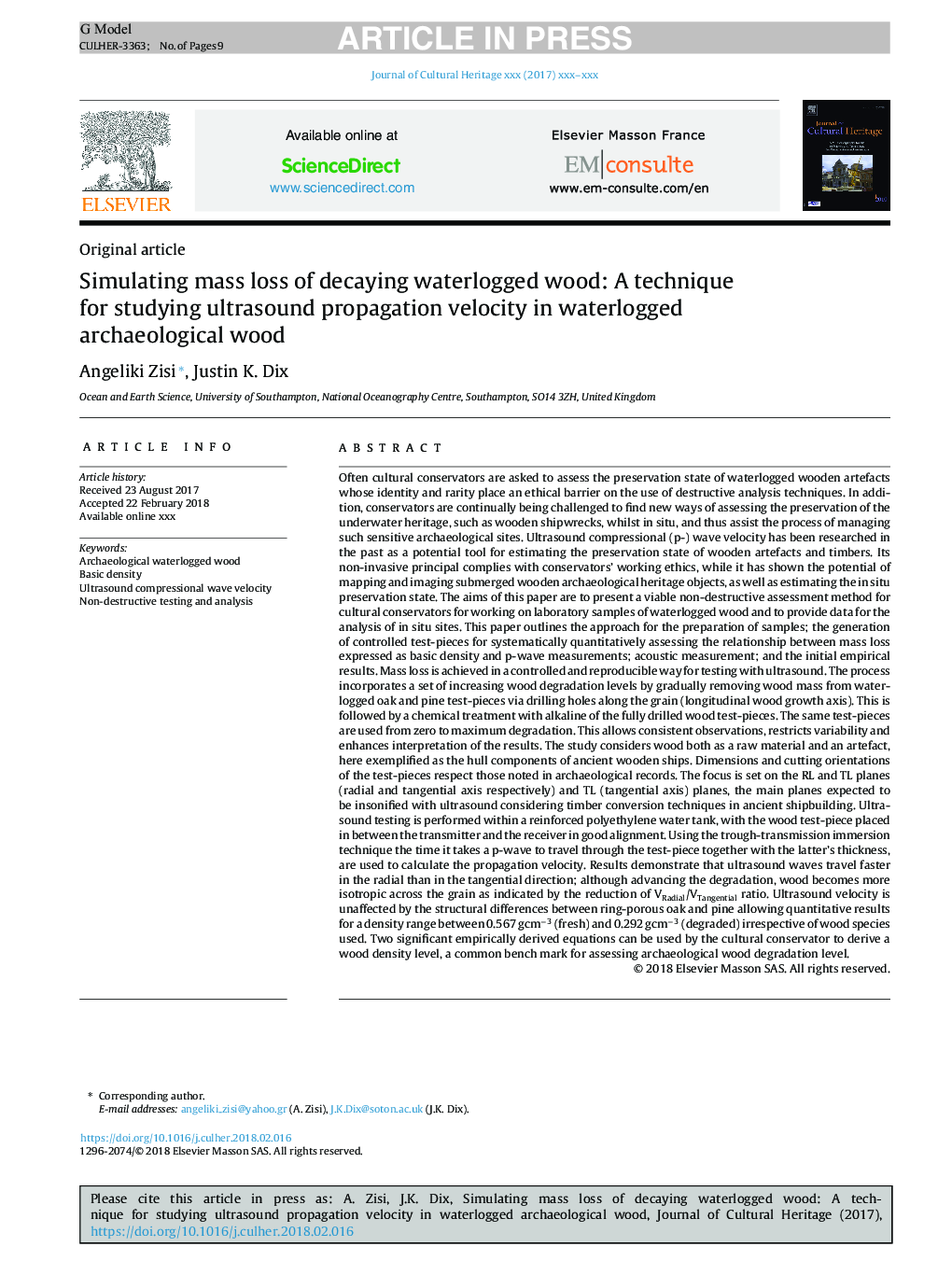| کد مقاله | کد نشریه | سال انتشار | مقاله انگلیسی | نسخه تمام متن |
|---|---|---|---|---|
| 8965273 | 1646714 | 2018 | 9 صفحه PDF | دانلود رایگان |
عنوان انگلیسی مقاله ISI
Simulating mass loss of decaying waterlogged wood: A technique for studying ultrasound propagation velocity in waterlogged archaeological wood
ترجمه فارسی عنوان
شبیه سازی از دست دادن وزن درختان دچار افتادگی: روش برای مطالعه سرعت انتشار اولتراسوند در چوب باستان شناسی غرق شده
دانلود مقاله + سفارش ترجمه
دانلود مقاله ISI انگلیسی
رایگان برای ایرانیان
کلمات کلیدی
چوب آبرنگ باقی مانده، تراکم اولیه، سرعت موج فشرده سونوگرافی، آزمایش و تجزیه و تحلیل غیر مخرب،
موضوعات مرتبط
مهندسی و علوم پایه
شیمی
شیمی تئوریک و عملی
چکیده انگلیسی
Often cultural conservators are asked to assess the preservation state of waterlogged wooden artefacts whose identity and rarity place an ethical barrier on the use of destructive analysis techniques. In addition, conservators are continually being challenged to find new ways of assessing the preservation of the underwater heritage, such as wooden shipwrecks, whilst in situ, and thus assist the process of managing such sensitive archaeological sites. Ultrasound compressional (p-) wave velocity has been researched in the past as a potential tool for estimating the preservation state of wooden artefacts and timbers. Its non-invasive principal complies with conservators' working ethics, while it has shown the potential of mapping and imaging submerged wooden archaeological heritage objects, as well as estimating the in situ preservation state. The aims of this paper are to present a viable non-destructive assessment method for cultural conservators for working on laboratory samples of waterlogged wood and to provide data for the analysis of in situ sites. This paper outlines the approach for the preparation of samples; the generation of controlled test-pieces for systematically quantitatively assessing the relationship between mass loss expressed as basic density and p-wave measurements; acoustic measurement; and the initial empirical results. Mass loss is achieved in a controlled and reproducible way for testing with ultrasound. The process incorporates a set of increasing wood degradation levels by gradually removing wood mass from waterlogged oak and pine test-pieces via drilling holes along the grain (longitudinal wood growth axis). This is followed by a chemical treatment with alkaline of the fully drilled wood test-pieces. The same test-pieces are used from zero to maximum degradation. This allows consistent observations, restricts variability and enhances interpretation of the results. The study considers wood both as a raw material and an artefact, here exemplified as the hull components of ancient wooden ships. Dimensions and cutting orientations of the test-pieces respect those noted in archaeological records. The focus is set on the RL and TL planes (radial and tangential axis respectively) and TL (tangential axis) planes, the main planes expected to be insonified with ultrasound considering timber conversion techniques in ancient shipbuilding. Ultrasound testing is performed within a reinforced polyethylene water tank, with the wood test-piece placed in between the transmitter and the receiver in good alignment. Using the trough-transmission immersion technique the time it takes a p-wave to travel through the test-piece together with the latter's thickness, are used to calculate the propagation velocity. Results demonstrate that ultrasound waves travel faster in the radial than in the tangential direction; although advancing the degradation, wood becomes more isotropic across the grain as indicated by the reduction of VRadial/VTangential ratio. Ultrasound velocity is unaffected by the structural differences between ring-porous oak and pine allowing quantitative results for a density range between 0.567Â gcmâ3 (fresh) and 0.292Â gcmâ3 (degraded) irrespective of wood species used. Two significant empirically derived equations can be used by the cultural conservator to derive a wood density level, a common bench mark for assessing archaeological wood degradation level.
ناشر
Database: Elsevier - ScienceDirect (ساینس دایرکت)
Journal: Journal of Cultural Heritage - Volume 33, SeptemberâOctober 2018, Pages 39-47
Journal: Journal of Cultural Heritage - Volume 33, SeptemberâOctober 2018, Pages 39-47
نویسندگان
Angeliki Zisi, Justin K. Dix,
